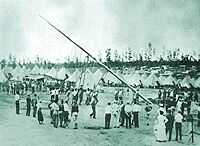Hattiesburg, a city of the new South, a railroad town which owes its existence to the post Civil
War transportation revolution, is located in the Piney Woods region of southern Mississippi. Before
the advent of railroads in southern Mississippi, Hattiesburg was just a small community located in
an area with vast timber resources, natural drainage, and adequate water supplies. Known first as
Twin Forks and later as Gordonville, after one of the original settlers, it acquired its present
designation after the Meridian-based, lumber-railroad magnate,
William Harris Hardy (1837-1917), selected the site for a station along a proposed Meridian to
New Orleans route for his New Orleans and Northeastern Railroad. This line was completed in 1883
and the settlement, incorporated as a town in 1884, was renamed Hattiesburg in honor of Hardy's
second wife, Hattie Lott Hardy (1848-1895).
The newly created town established an economic base dependent on the yellow-pine lumber mill and
turpentine industry and transportation. These industries helped fashion Hattiesburg into a thriving
production and distribution center for southern Mississippi. The local transportation boom turned
Hattiesburg into a hub for four railroads: the New Orleans and Northeastern, later part of the
Southern Railroad System; the Gulf and Ship Island Railroad,
sold to the Illinois Central Railroad
in 1925; the Mississippi Central Railroad; and the Mobile, Jackson, and Kansas City Railroad which
later became the Bonhomie and Hattiesburg Southern Railroad.
Hattiesburg, or the Hub City as it became popularly known, grew slowly
and steadily from 1884 to 1900 with a population of 400 in 1885, 1172 in 1890, and 4175 in
1900. Continued steady expansion enabled Hattiesburg to petition the Mississippi legislature for a
city charter in 1890 and it subsequently, as the largest community in the area, became county seat
for Forrest County when that county was created in 1908 from Perry County. With the
lumber-transportation industries firmly established by the turn of the century, Hattiesburg a newly
 |
|
Camp Shelby
|
created city, a sense of prosperity developing, and the subsequent selection of a site just south
of Hattiesburg for Camp Shelby, a military training base, the city experienced rapid growth,
attaining a population of 11,733 in 1910, 13,270 in 1920 and 18,600 in 1930.
By 1915 large areas of timber land had been clear-cut, and mills, for lack of plentiful and
accessible timber and lucrative timber-related business prospects and opportunities, began to
dismantle their operations. Industrial demands during World War I temporarily ended mill closures
in the Hattiesburg area by creating an artificial stimulus for lumber and lumber-related products,
thus prolonging the life of an ailing local lumber industry. War demands, while creating steady but
inflated income for Hattiesburg area residents, prevented the community from developing new
industries to replace those becoming obsolete or unremunerative. Following World War I, the
dismantling of Camp Shelby, and the closure of uneconomical lumber mills, Hattiesburg suffered
decline and depression. It was apparent that for Hattiesburg to survive a new way of life was
necessary. Although hampered by a depression-induced capital shortage, efforts to expand and create
new business and industry were sometimes innovative as in the introduction of the Tung Oil
industry. World War II proved a watershed for Hattiesburg. It brought to a close the depression and
initiated a slow process of commercializing Hattiesburg's economic base that is continuing today.
Camp Shelby was revitalized as a National Guard Camp. Hattiesburg evolved into a wholesale and
retail trade, medical, and educational center for southern Mississippi, and the city experienced a
population surge, expanding from 21,026 in 1940 to 34,989 in 1960, and 40,829 in 1980.
Hattiesburg, to accommodate growth cycles and changing industrial and community needs, has
through the years taken initiative to alter and improve its form of government. Since its
inception, Hattiesburg has operated under three different forms of government and two charters.
Hattiesburg was chartered first in 1884 as a town and then again in 1890 as a city. According to
extant records, in the first election, held in 1884, the citizenry elected Oliver Hazzard Perry
Jones as mayor to govern their town. In the second election, held just one year later in 1885, the
citizens elected a mayor and board of eight aldermen. The Mayor/Alderman form of government
serviced Hattiesburg from 1885 to 1911. In 1911 Hattiesburg became the first city in Mississippi to
adopt a City Commission form of government calling for election of a mayor and two commissioners.
Since 1985 Hattiesburg has operated under a Mayor/Council form of government

